Analysis of Hurricane Harvey Disaster Using Four Ways of Thinking
VerifiedAdded on 2022/11/28
|7
|1853
|366
Report
AI Summary
This report provides a comprehensive analysis of the Hurricane Harvey disaster through the lens of the Four Ways of Thinking framework: systems thinking, values thinking, futures thinking, and strategic thinking. It examines the interconnected systems at play, highlighting how Houston's development and geography contributed to the flooding. The report delves into the values prioritized by developers and government agencies, revealing a focus on economic development over resident safety, which led to devastating environmental and health consequences. By applying futures thinking, the report identifies past decisions and climate change as key factors increasing Houston's vulnerability. Finally, it proposes strategic solutions, including policy changes, improved infrastructure, and community education, to mitigate future flood risks and promote sustainable urban planning. The analysis underscores the importance of integrating these four thinking approaches to achieve sustainability and prevent similar disasters in the future.
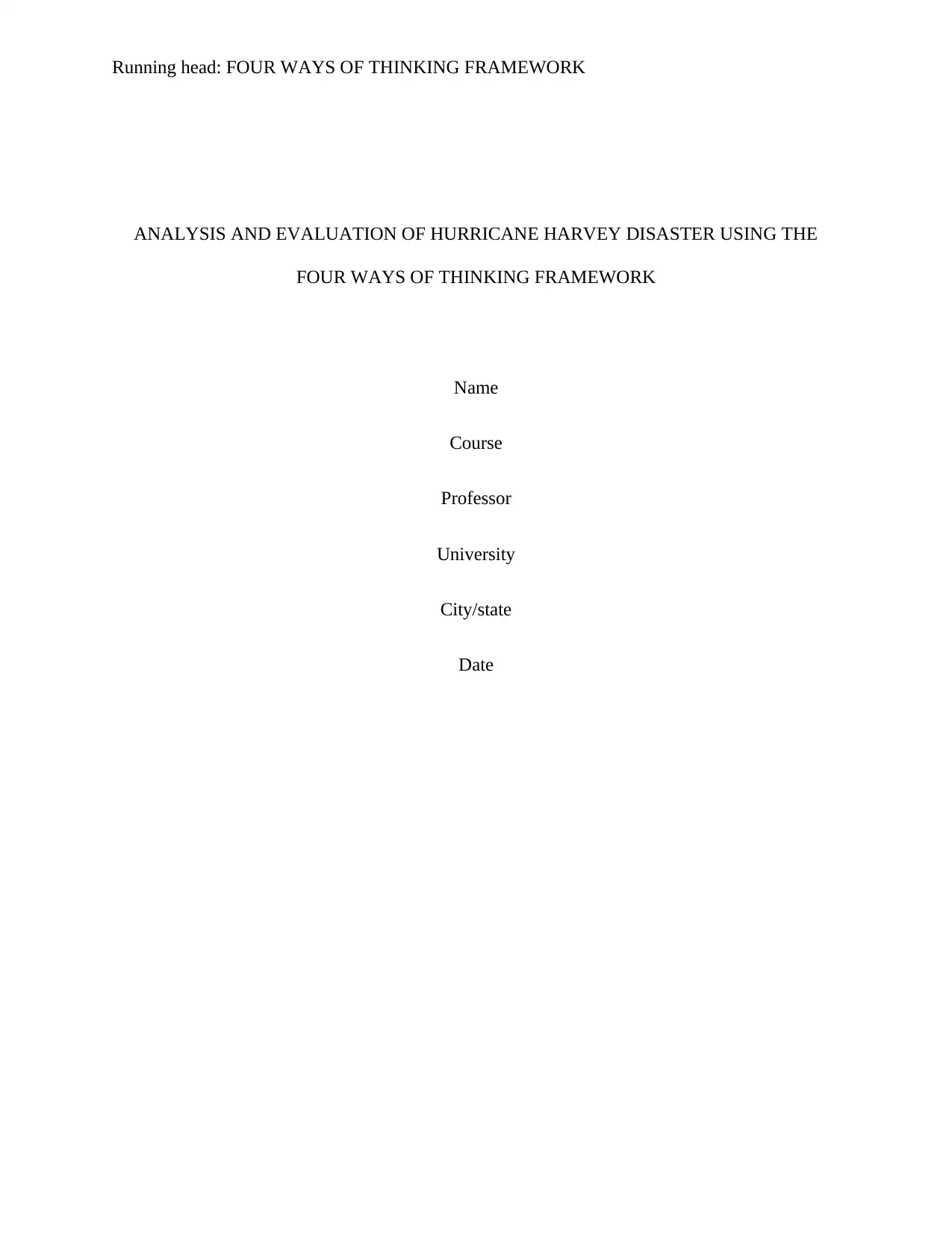
Running head: FOUR WAYS OF THINKING FRAMEWORK
ANALYSIS AND EVALUATION OF HURRICANE HARVEY DISASTER USING THE
FOUR WAYS OF THINKING FRAMEWORK
Name
Course
Professor
University
City/state
Date
ANALYSIS AND EVALUATION OF HURRICANE HARVEY DISASTER USING THE
FOUR WAYS OF THINKING FRAMEWORK
Name
Course
Professor
University
City/state
Date
Paraphrase This Document
Need a fresh take? Get an instant paraphrase of this document with our AI Paraphraser
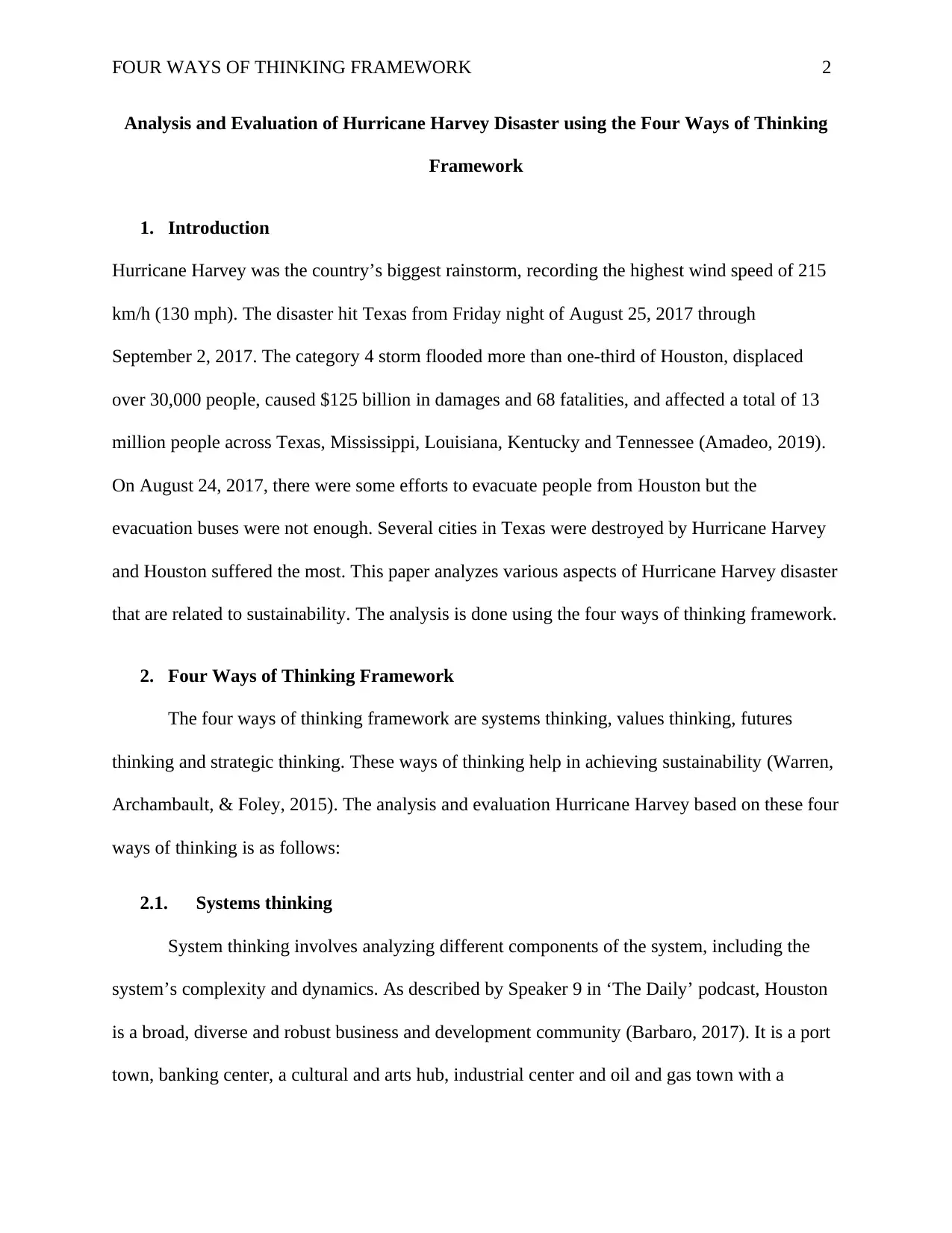
FOUR WAYS OF THINKING FRAMEWORK 2
Analysis and Evaluation of Hurricane Harvey Disaster using the Four Ways of Thinking
Framework
1. Introduction
Hurricane Harvey was the country’s biggest rainstorm, recording the highest wind speed of 215
km/h (130 mph). The disaster hit Texas from Friday night of August 25, 2017 through
September 2, 2017. The category 4 storm flooded more than one-third of Houston, displaced
over 30,000 people, caused $125 billion in damages and 68 fatalities, and affected a total of 13
million people across Texas, Mississippi, Louisiana, Kentucky and Tennessee (Amadeo, 2019).
On August 24, 2017, there were some efforts to evacuate people from Houston but the
evacuation buses were not enough. Several cities in Texas were destroyed by Hurricane Harvey
and Houston suffered the most. This paper analyzes various aspects of Hurricane Harvey disaster
that are related to sustainability. The analysis is done using the four ways of thinking framework.
2. Four Ways of Thinking Framework
The four ways of thinking framework are systems thinking, values thinking, futures
thinking and strategic thinking. These ways of thinking help in achieving sustainability (Warren,
Archambault, & Foley, 2015). The analysis and evaluation Hurricane Harvey based on these four
ways of thinking is as follows:
2.1. Systems thinking
System thinking involves analyzing different components of the system, including the
system’s complexity and dynamics. As described by Speaker 9 in ‘The Daily’ podcast, Houston
is a broad, diverse and robust business and development community (Barbaro, 2017). It is a port
town, banking center, a cultural and arts hub, industrial center and oil and gas town with a
Analysis and Evaluation of Hurricane Harvey Disaster using the Four Ways of Thinking
Framework
1. Introduction
Hurricane Harvey was the country’s biggest rainstorm, recording the highest wind speed of 215
km/h (130 mph). The disaster hit Texas from Friday night of August 25, 2017 through
September 2, 2017. The category 4 storm flooded more than one-third of Houston, displaced
over 30,000 people, caused $125 billion in damages and 68 fatalities, and affected a total of 13
million people across Texas, Mississippi, Louisiana, Kentucky and Tennessee (Amadeo, 2019).
On August 24, 2017, there were some efforts to evacuate people from Houston but the
evacuation buses were not enough. Several cities in Texas were destroyed by Hurricane Harvey
and Houston suffered the most. This paper analyzes various aspects of Hurricane Harvey disaster
that are related to sustainability. The analysis is done using the four ways of thinking framework.
2. Four Ways of Thinking Framework
The four ways of thinking framework are systems thinking, values thinking, futures
thinking and strategic thinking. These ways of thinking help in achieving sustainability (Warren,
Archambault, & Foley, 2015). The analysis and evaluation Hurricane Harvey based on these four
ways of thinking is as follows:
2.1. Systems thinking
System thinking involves analyzing different components of the system, including the
system’s complexity and dynamics. As described by Speaker 9 in ‘The Daily’ podcast, Houston
is a broad, diverse and robust business and development community (Barbaro, 2017). It is a port
town, banking center, a cultural and arts hub, industrial center and oil and gas town with a
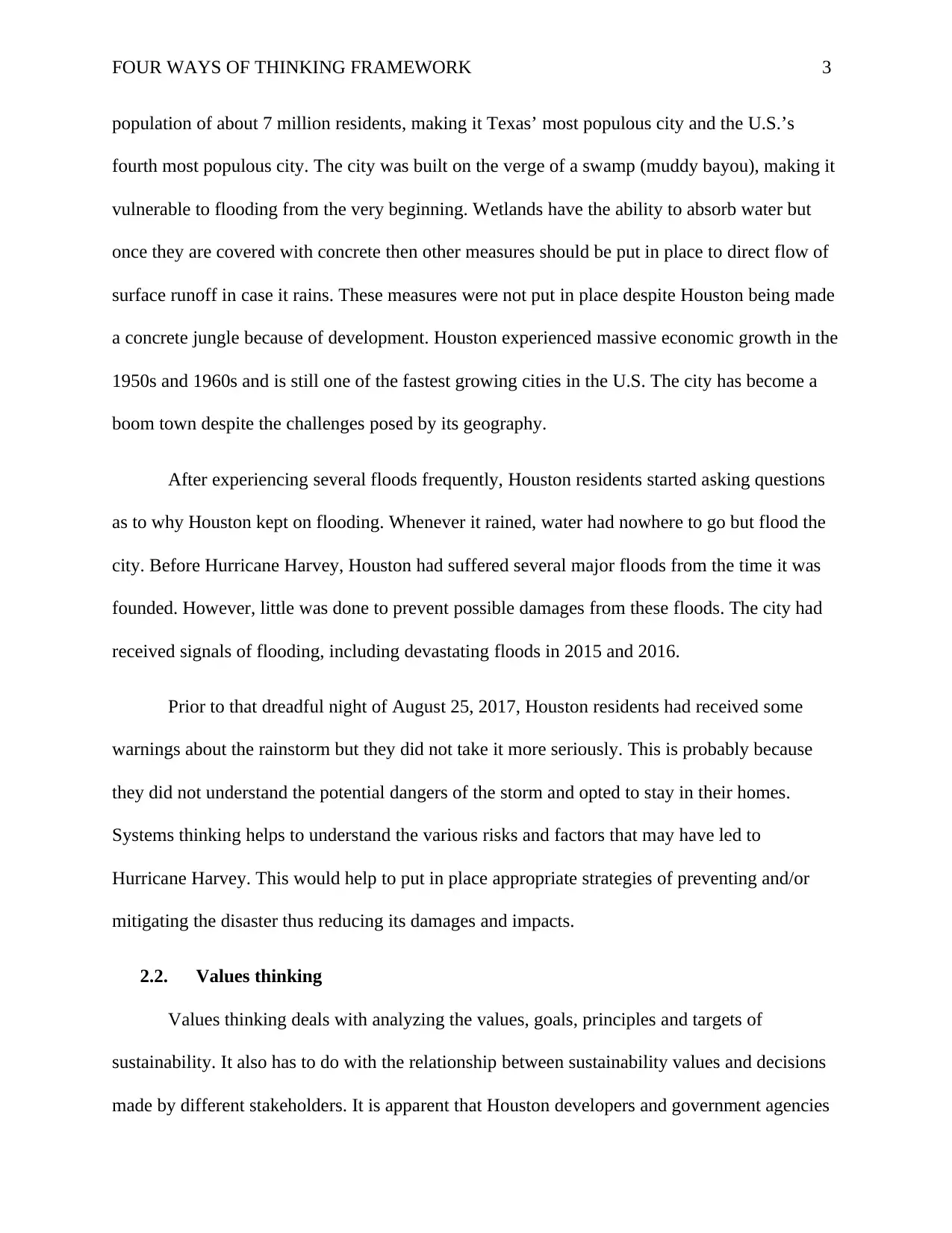
FOUR WAYS OF THINKING FRAMEWORK 3
population of about 7 million residents, making it Texas’ most populous city and the U.S.’s
fourth most populous city. The city was built on the verge of a swamp (muddy bayou), making it
vulnerable to flooding from the very beginning. Wetlands have the ability to absorb water but
once they are covered with concrete then other measures should be put in place to direct flow of
surface runoff in case it rains. These measures were not put in place despite Houston being made
a concrete jungle because of development. Houston experienced massive economic growth in the
1950s and 1960s and is still one of the fastest growing cities in the U.S. The city has become a
boom town despite the challenges posed by its geography.
After experiencing several floods frequently, Houston residents started asking questions
as to why Houston kept on flooding. Whenever it rained, water had nowhere to go but flood the
city. Before Hurricane Harvey, Houston had suffered several major floods from the time it was
founded. However, little was done to prevent possible damages from these floods. The city had
received signals of flooding, including devastating floods in 2015 and 2016.
Prior to that dreadful night of August 25, 2017, Houston residents had received some
warnings about the rainstorm but they did not take it more seriously. This is probably because
they did not understand the potential dangers of the storm and opted to stay in their homes.
Systems thinking helps to understand the various risks and factors that may have led to
Hurricane Harvey. This would help to put in place appropriate strategies of preventing and/or
mitigating the disaster thus reducing its damages and impacts.
2.2. Values thinking
Values thinking deals with analyzing the values, goals, principles and targets of
sustainability. It also has to do with the relationship between sustainability values and decisions
made by different stakeholders. It is apparent that Houston developers and government agencies
population of about 7 million residents, making it Texas’ most populous city and the U.S.’s
fourth most populous city. The city was built on the verge of a swamp (muddy bayou), making it
vulnerable to flooding from the very beginning. Wetlands have the ability to absorb water but
once they are covered with concrete then other measures should be put in place to direct flow of
surface runoff in case it rains. These measures were not put in place despite Houston being made
a concrete jungle because of development. Houston experienced massive economic growth in the
1950s and 1960s and is still one of the fastest growing cities in the U.S. The city has become a
boom town despite the challenges posed by its geography.
After experiencing several floods frequently, Houston residents started asking questions
as to why Houston kept on flooding. Whenever it rained, water had nowhere to go but flood the
city. Before Hurricane Harvey, Houston had suffered several major floods from the time it was
founded. However, little was done to prevent possible damages from these floods. The city had
received signals of flooding, including devastating floods in 2015 and 2016.
Prior to that dreadful night of August 25, 2017, Houston residents had received some
warnings about the rainstorm but they did not take it more seriously. This is probably because
they did not understand the potential dangers of the storm and opted to stay in their homes.
Systems thinking helps to understand the various risks and factors that may have led to
Hurricane Harvey. This would help to put in place appropriate strategies of preventing and/or
mitigating the disaster thus reducing its damages and impacts.
2.2. Values thinking
Values thinking deals with analyzing the values, goals, principles and targets of
sustainability. It also has to do with the relationship between sustainability values and decisions
made by different stakeholders. It is apparent that Houston developers and government agencies
⊘ This is a preview!⊘
Do you want full access?
Subscribe today to unlock all pages.

Trusted by 1+ million students worldwide
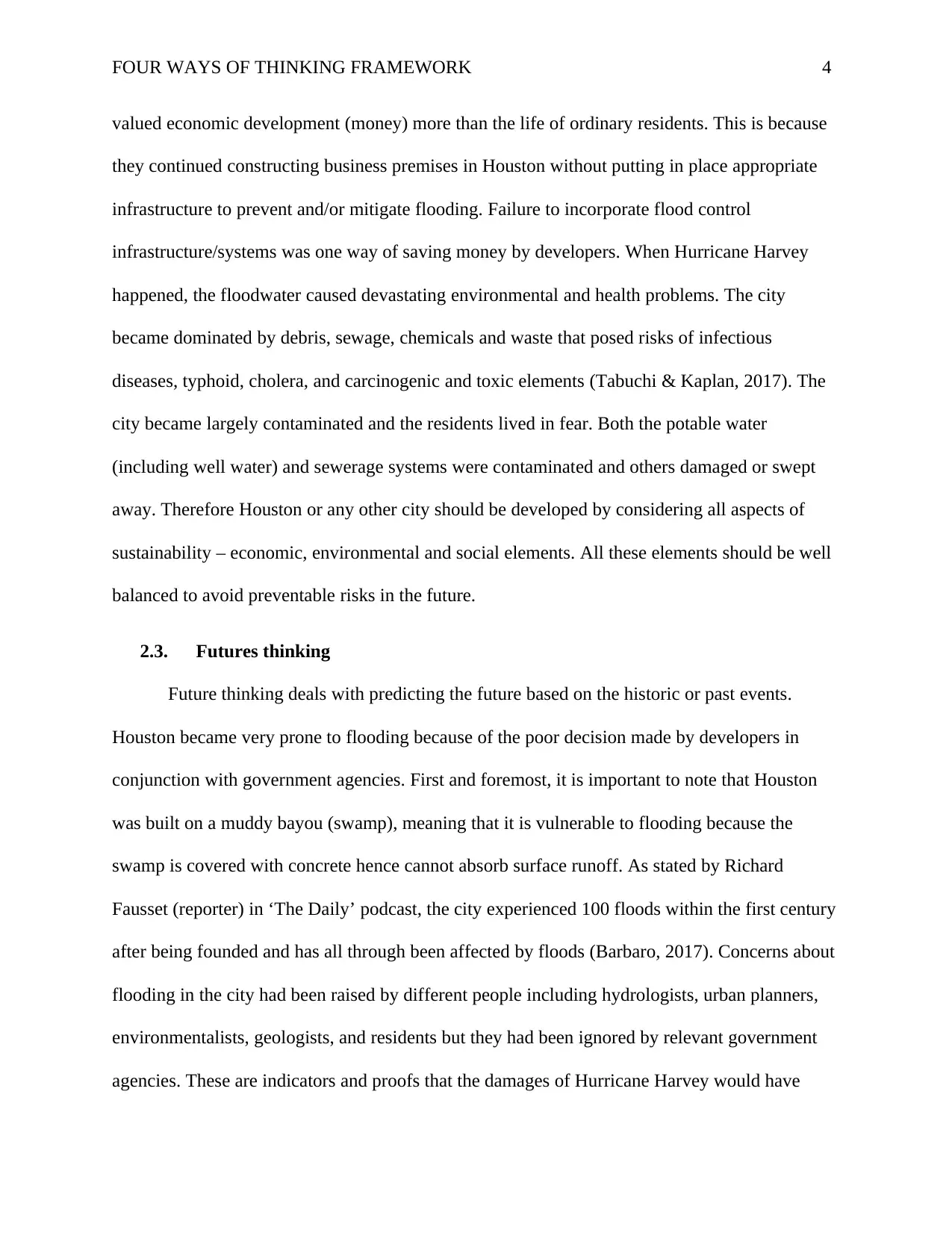
FOUR WAYS OF THINKING FRAMEWORK 4
valued economic development (money) more than the life of ordinary residents. This is because
they continued constructing business premises in Houston without putting in place appropriate
infrastructure to prevent and/or mitigate flooding. Failure to incorporate flood control
infrastructure/systems was one way of saving money by developers. When Hurricane Harvey
happened, the floodwater caused devastating environmental and health problems. The city
became dominated by debris, sewage, chemicals and waste that posed risks of infectious
diseases, typhoid, cholera, and carcinogenic and toxic elements (Tabuchi & Kaplan, 2017). The
city became largely contaminated and the residents lived in fear. Both the potable water
(including well water) and sewerage systems were contaminated and others damaged or swept
away. Therefore Houston or any other city should be developed by considering all aspects of
sustainability – economic, environmental and social elements. All these elements should be well
balanced to avoid preventable risks in the future.
2.3. Futures thinking
Future thinking deals with predicting the future based on the historic or past events.
Houston became very prone to flooding because of the poor decision made by developers in
conjunction with government agencies. First and foremost, it is important to note that Houston
was built on a muddy bayou (swamp), meaning that it is vulnerable to flooding because the
swamp is covered with concrete hence cannot absorb surface runoff. As stated by Richard
Fausset (reporter) in ‘The Daily’ podcast, the city experienced 100 floods within the first century
after being founded and has all through been affected by floods (Barbaro, 2017). Concerns about
flooding in the city had been raised by different people including hydrologists, urban planners,
environmentalists, geologists, and residents but they had been ignored by relevant government
agencies. These are indicators and proofs that the damages of Hurricane Harvey would have
valued economic development (money) more than the life of ordinary residents. This is because
they continued constructing business premises in Houston without putting in place appropriate
infrastructure to prevent and/or mitigate flooding. Failure to incorporate flood control
infrastructure/systems was one way of saving money by developers. When Hurricane Harvey
happened, the floodwater caused devastating environmental and health problems. The city
became dominated by debris, sewage, chemicals and waste that posed risks of infectious
diseases, typhoid, cholera, and carcinogenic and toxic elements (Tabuchi & Kaplan, 2017). The
city became largely contaminated and the residents lived in fear. Both the potable water
(including well water) and sewerage systems were contaminated and others damaged or swept
away. Therefore Houston or any other city should be developed by considering all aspects of
sustainability – economic, environmental and social elements. All these elements should be well
balanced to avoid preventable risks in the future.
2.3. Futures thinking
Future thinking deals with predicting the future based on the historic or past events.
Houston became very prone to flooding because of the poor decision made by developers in
conjunction with government agencies. First and foremost, it is important to note that Houston
was built on a muddy bayou (swamp), meaning that it is vulnerable to flooding because the
swamp is covered with concrete hence cannot absorb surface runoff. As stated by Richard
Fausset (reporter) in ‘The Daily’ podcast, the city experienced 100 floods within the first century
after being founded and has all through been affected by floods (Barbaro, 2017). Concerns about
flooding in the city had been raised by different people including hydrologists, urban planners,
environmentalists, geologists, and residents but they had been ignored by relevant government
agencies. These are indicators and proofs that the damages of Hurricane Harvey would have
Paraphrase This Document
Need a fresh take? Get an instant paraphrase of this document with our AI Paraphraser
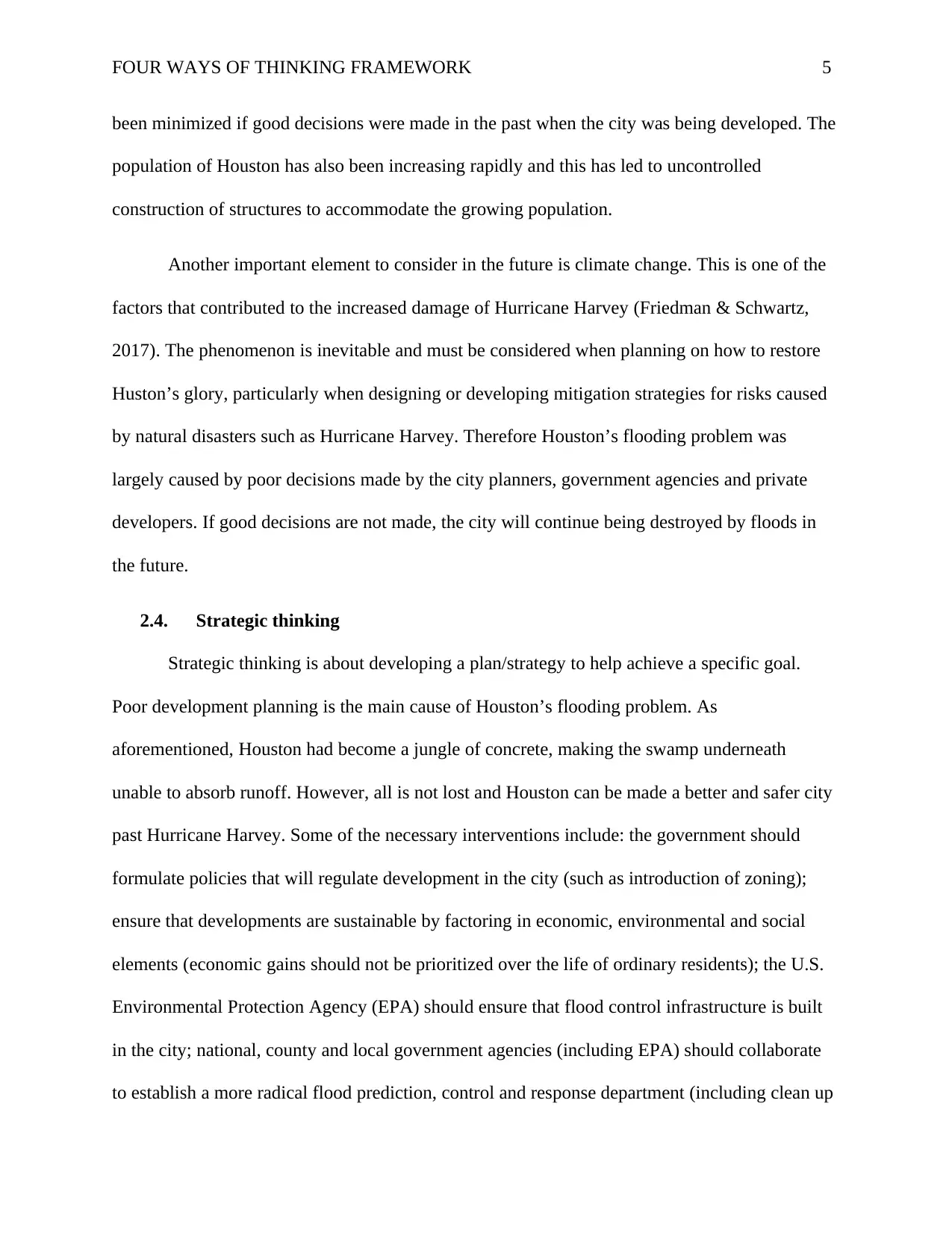
FOUR WAYS OF THINKING FRAMEWORK 5
been minimized if good decisions were made in the past when the city was being developed. The
population of Houston has also been increasing rapidly and this has led to uncontrolled
construction of structures to accommodate the growing population.
Another important element to consider in the future is climate change. This is one of the
factors that contributed to the increased damage of Hurricane Harvey (Friedman & Schwartz,
2017). The phenomenon is inevitable and must be considered when planning on how to restore
Huston’s glory, particularly when designing or developing mitigation strategies for risks caused
by natural disasters such as Hurricane Harvey. Therefore Houston’s flooding problem was
largely caused by poor decisions made by the city planners, government agencies and private
developers. If good decisions are not made, the city will continue being destroyed by floods in
the future.
2.4. Strategic thinking
Strategic thinking is about developing a plan/strategy to help achieve a specific goal.
Poor development planning is the main cause of Houston’s flooding problem. As
aforementioned, Houston had become a jungle of concrete, making the swamp underneath
unable to absorb runoff. However, all is not lost and Houston can be made a better and safer city
past Hurricane Harvey. Some of the necessary interventions include: the government should
formulate policies that will regulate development in the city (such as introduction of zoning);
ensure that developments are sustainable by factoring in economic, environmental and social
elements (economic gains should not be prioritized over the life of ordinary residents); the U.S.
Environmental Protection Agency (EPA) should ensure that flood control infrastructure is built
in the city; national, county and local government agencies (including EPA) should collaborate
to establish a more radical flood prediction, control and response department (including clean up
been minimized if good decisions were made in the past when the city was being developed. The
population of Houston has also been increasing rapidly and this has led to uncontrolled
construction of structures to accommodate the growing population.
Another important element to consider in the future is climate change. This is one of the
factors that contributed to the increased damage of Hurricane Harvey (Friedman & Schwartz,
2017). The phenomenon is inevitable and must be considered when planning on how to restore
Huston’s glory, particularly when designing or developing mitigation strategies for risks caused
by natural disasters such as Hurricane Harvey. Therefore Houston’s flooding problem was
largely caused by poor decisions made by the city planners, government agencies and private
developers. If good decisions are not made, the city will continue being destroyed by floods in
the future.
2.4. Strategic thinking
Strategic thinking is about developing a plan/strategy to help achieve a specific goal.
Poor development planning is the main cause of Houston’s flooding problem. As
aforementioned, Houston had become a jungle of concrete, making the swamp underneath
unable to absorb runoff. However, all is not lost and Houston can be made a better and safer city
past Hurricane Harvey. Some of the necessary interventions include: the government should
formulate policies that will regulate development in the city (such as introduction of zoning);
ensure that developments are sustainable by factoring in economic, environmental and social
elements (economic gains should not be prioritized over the life of ordinary residents); the U.S.
Environmental Protection Agency (EPA) should ensure that flood control infrastructure is built
in the city; national, county and local government agencies (including EPA) should collaborate
to establish a more radical flood prediction, control and response department (including clean up
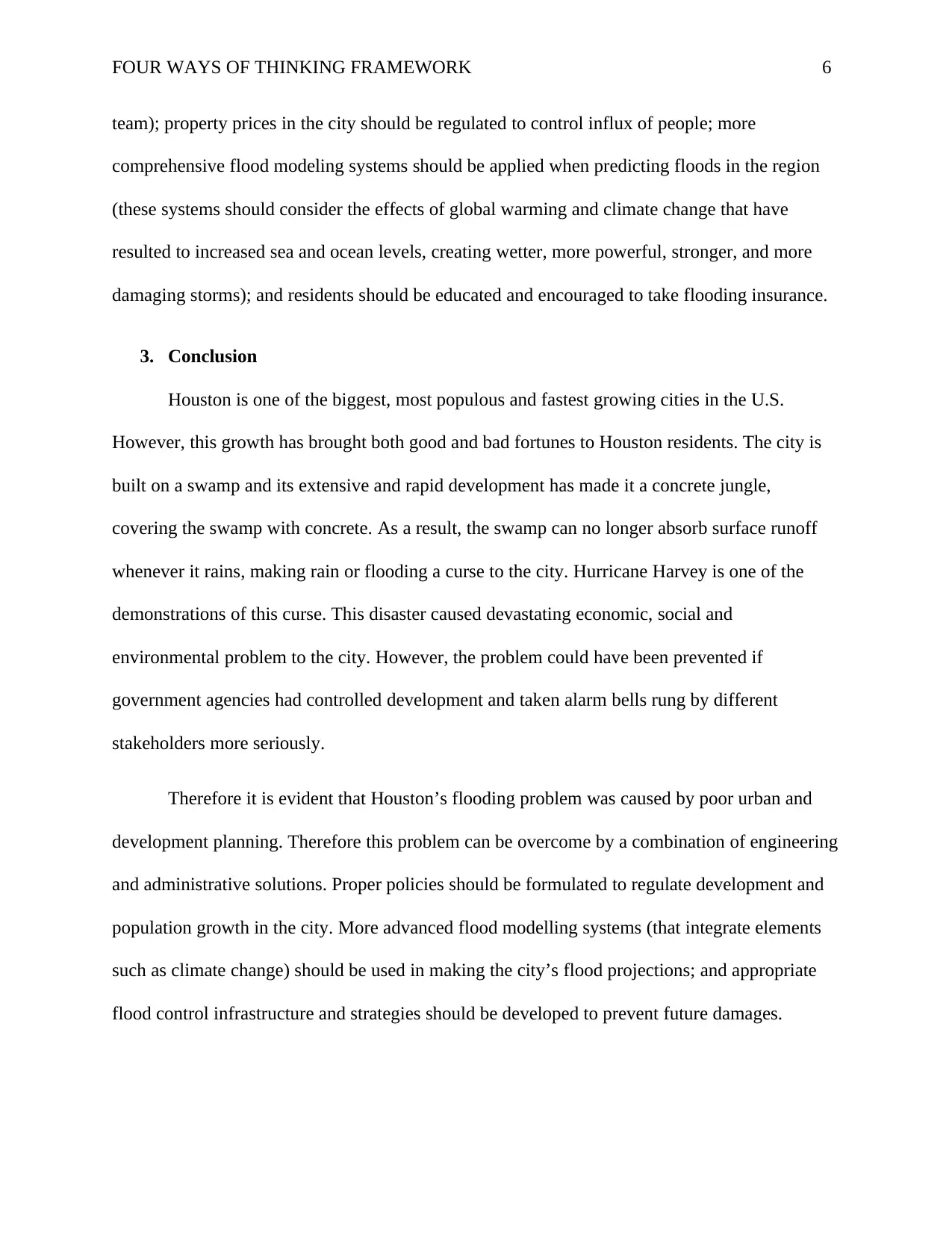
FOUR WAYS OF THINKING FRAMEWORK 6
team); property prices in the city should be regulated to control influx of people; more
comprehensive flood modeling systems should be applied when predicting floods in the region
(these systems should consider the effects of global warming and climate change that have
resulted to increased sea and ocean levels, creating wetter, more powerful, stronger, and more
damaging storms); and residents should be educated and encouraged to take flooding insurance.
3. Conclusion
Houston is one of the biggest, most populous and fastest growing cities in the U.S.
However, this growth has brought both good and bad fortunes to Houston residents. The city is
built on a swamp and its extensive and rapid development has made it a concrete jungle,
covering the swamp with concrete. As a result, the swamp can no longer absorb surface runoff
whenever it rains, making rain or flooding a curse to the city. Hurricane Harvey is one of the
demonstrations of this curse. This disaster caused devastating economic, social and
environmental problem to the city. However, the problem could have been prevented if
government agencies had controlled development and taken alarm bells rung by different
stakeholders more seriously.
Therefore it is evident that Houston’s flooding problem was caused by poor urban and
development planning. Therefore this problem can be overcome by a combination of engineering
and administrative solutions. Proper policies should be formulated to regulate development and
population growth in the city. More advanced flood modelling systems (that integrate elements
such as climate change) should be used in making the city’s flood projections; and appropriate
flood control infrastructure and strategies should be developed to prevent future damages.
team); property prices in the city should be regulated to control influx of people; more
comprehensive flood modeling systems should be applied when predicting floods in the region
(these systems should consider the effects of global warming and climate change that have
resulted to increased sea and ocean levels, creating wetter, more powerful, stronger, and more
damaging storms); and residents should be educated and encouraged to take flooding insurance.
3. Conclusion
Houston is one of the biggest, most populous and fastest growing cities in the U.S.
However, this growth has brought both good and bad fortunes to Houston residents. The city is
built on a swamp and its extensive and rapid development has made it a concrete jungle,
covering the swamp with concrete. As a result, the swamp can no longer absorb surface runoff
whenever it rains, making rain or flooding a curse to the city. Hurricane Harvey is one of the
demonstrations of this curse. This disaster caused devastating economic, social and
environmental problem to the city. However, the problem could have been prevented if
government agencies had controlled development and taken alarm bells rung by different
stakeholders more seriously.
Therefore it is evident that Houston’s flooding problem was caused by poor urban and
development planning. Therefore this problem can be overcome by a combination of engineering
and administrative solutions. Proper policies should be formulated to regulate development and
population growth in the city. More advanced flood modelling systems (that integrate elements
such as climate change) should be used in making the city’s flood projections; and appropriate
flood control infrastructure and strategies should be developed to prevent future damages.
⊘ This is a preview!⊘
Do you want full access?
Subscribe today to unlock all pages.

Trusted by 1+ million students worldwide
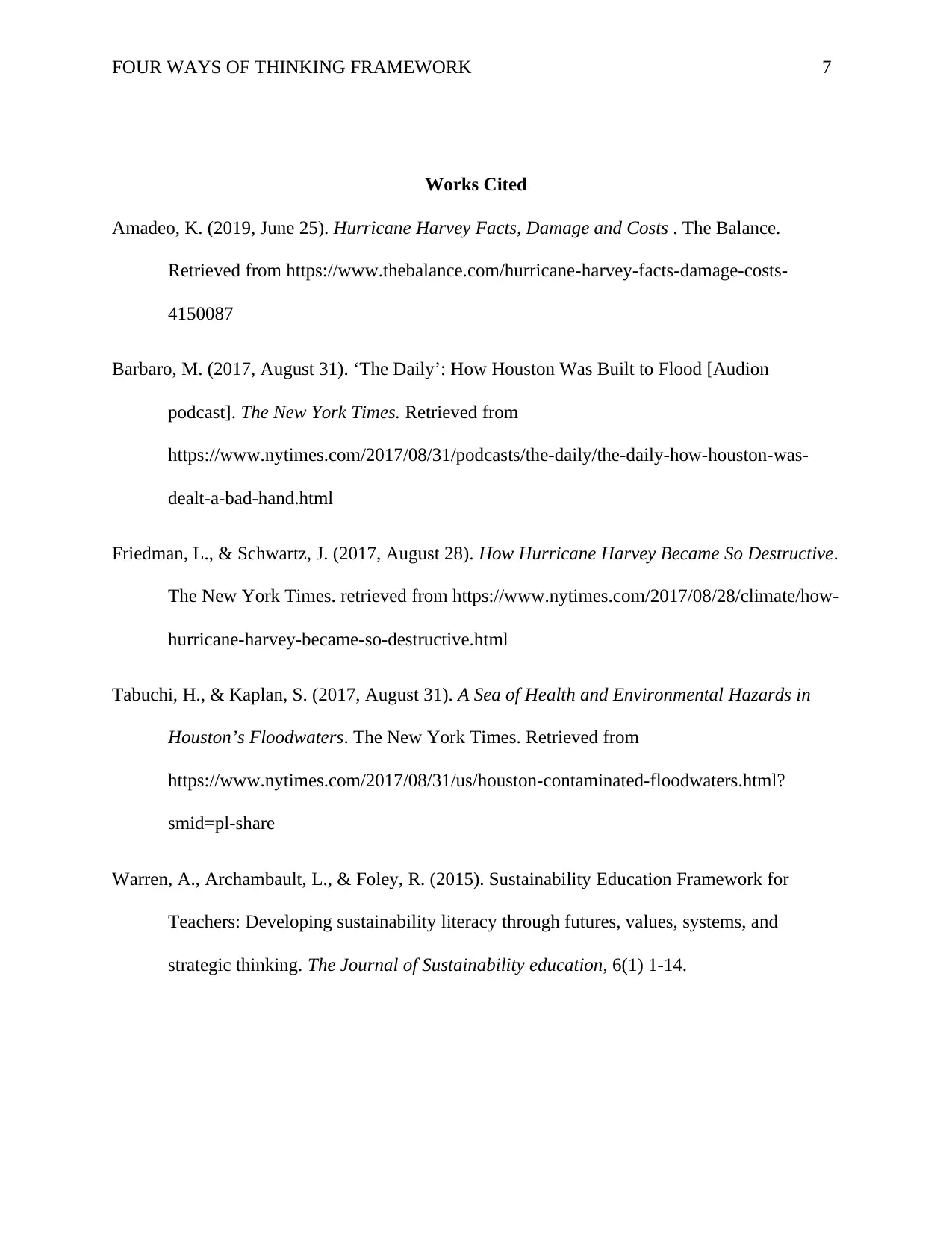
FOUR WAYS OF THINKING FRAMEWORK 7
Works Cited
Amadeo, K. (2019, June 25). Hurricane Harvey Facts, Damage and Costs . The Balance.
Retrieved from https://www.thebalance.com/hurricane-harvey-facts-damage-costs-
4150087
Barbaro, M. (2017, August 31). ‘The Daily’: How Houston Was Built to Flood [Audion
podcast]. The New York Times. Retrieved from
https://www.nytimes.com/2017/08/31/podcasts/the-daily/the-daily-how-houston-was-
dealt-a-bad-hand.html
Friedman, L., & Schwartz, J. (2017, August 28). How Hurricane Harvey Became So Destructive.
The New York Times. retrieved from https://www.nytimes.com/2017/08/28/climate/how-
hurricane-harvey-became-so-destructive.html
Tabuchi, H., & Kaplan, S. (2017, August 31). A Sea of Health and Environmental Hazards in
Houston’s Floodwaters. The New York Times. Retrieved from
https://www.nytimes.com/2017/08/31/us/houston-contaminated-floodwaters.html?
smid=pl-share
Warren, A., Archambault, L., & Foley, R. (2015). Sustainability Education Framework for
Teachers: Developing sustainability literacy through futures, values, systems, and
strategic thinking. The Journal of Sustainability education, 6(1) 1-14.
Works Cited
Amadeo, K. (2019, June 25). Hurricane Harvey Facts, Damage and Costs . The Balance.
Retrieved from https://www.thebalance.com/hurricane-harvey-facts-damage-costs-
4150087
Barbaro, M. (2017, August 31). ‘The Daily’: How Houston Was Built to Flood [Audion
podcast]. The New York Times. Retrieved from
https://www.nytimes.com/2017/08/31/podcasts/the-daily/the-daily-how-houston-was-
dealt-a-bad-hand.html
Friedman, L., & Schwartz, J. (2017, August 28). How Hurricane Harvey Became So Destructive.
The New York Times. retrieved from https://www.nytimes.com/2017/08/28/climate/how-
hurricane-harvey-became-so-destructive.html
Tabuchi, H., & Kaplan, S. (2017, August 31). A Sea of Health and Environmental Hazards in
Houston’s Floodwaters. The New York Times. Retrieved from
https://www.nytimes.com/2017/08/31/us/houston-contaminated-floodwaters.html?
smid=pl-share
Warren, A., Archambault, L., & Foley, R. (2015). Sustainability Education Framework for
Teachers: Developing sustainability literacy through futures, values, systems, and
strategic thinking. The Journal of Sustainability education, 6(1) 1-14.
1 out of 7
Your All-in-One AI-Powered Toolkit for Academic Success.
+13062052269
info@desklib.com
Available 24*7 on WhatsApp / Email
![[object Object]](/_next/static/media/star-bottom.7253800d.svg)
Unlock your academic potential
Copyright © 2020–2025 A2Z Services. All Rights Reserved. Developed and managed by ZUCOL.

